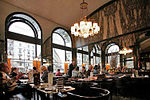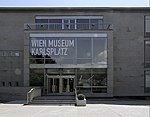Musikverein

The Wiener Musikverein (German for 'Viennese Music Association'; German: [ˌviːnɐ muˈziːkfɐ̯ˌaɪn] or German: [ˌviːnɐ muˈziːkfəˌʁaɪn]), commonly shortened to Musikverein, is a concert hall in Vienna, Austria, which is located in the Innere Stadt district. The building opened in 1870 and is the home of the Vienna Philharmonic orchestra. The acoustics of the building's 'Great Hall' (Großer Saal) have earned it recognition alongside other prominent concert halls, such as the Konzerthaus in Berlin, the Concertgebouw in Amsterdam and Symphony Hall in Boston. With the exception of Boston's Symphony Hall, none of these halls was built in the modern era with the application of architectural acoustics, and all share a long, tall and narrow shoebox shape.
Excerpt from the Wikipedia article Musikverein (License: CC BY-SA 3.0, Authors, Images).Musikverein
Musikvereinsplatz, Vienna Innere Stadt
Geographical coordinates (GPS) Address Nearby Places Show on map
Geographical coordinates (GPS)
| Latitude | Longitude |
|---|---|
| N 48.200555555556 ° | E 16.372222222222 ° |
Address
Musikvereinsplatz
Musikvereinsplatz
1010 Vienna, Innere Stadt
Austria
Open on Google Maps










